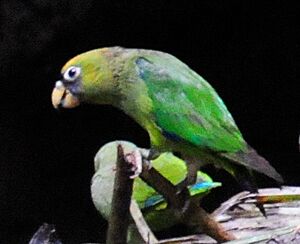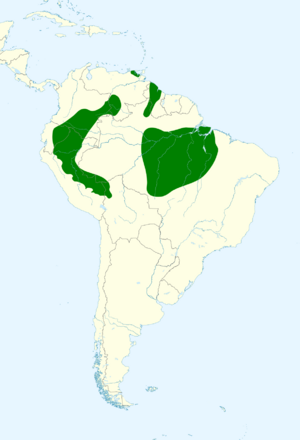Scarlet-shouldered parrotlet facts for kids
Quick facts for kids Scarlet-shouldered parrotlet |
|
|---|---|
 |
|
| At a clay lick in Yasuni National Park, Ecuador | |
| Conservation status | |
| Scientific classification | |
| Genus: |
Touit
|
| Species: |
huetii
|
 |
|
The scarlet-shouldered parrotlet (Touit huetii) is a small, colorful bird. It is also known as the red-winged parrotlet or Huet's parrotlet. This parrot lives in parts of South America, including Bolivia, Brazil, Colombia, Ecuador, Guyana, Peru, and Venezuela. Sometimes, it might even visit Suriname or Trinidad and Tobago.
Contents
What Does It Look Like?
The scarlet-shouldered parrotlet is about 15 to 16 cm (5.9 to 6.3 in) long. That's about the size of a small ruler! It weighs around 58 to 62 g (2.0 to 2.2 oz), which is lighter than a tennis ball.
Most of its body is green, but it's darker on its back and lighter on its belly. Its face is dark, and it has a white ring around its eyes. The top of its head and the back of its neck are olive-brown.
Its wings are very special. The upper parts of its wings are dark blue. The main flight feathers are black. It has bright red patches under its wings and on a part called the carpal bar.
The male and female parrotlets have slightly different tails. Males have green feathers in the middle of their tail, with red feathers on the outside that have black tips. Females have tails that are all greenish-yellow with black tips. Both males and females have yellow feathers under their tails. Young parrotlets look a lot like adult females, but their faces are green.
Where It Lives and Its Home
The scarlet-shouldered parrotlet lives in different areas that are not connected. You can find it in northeastern Venezuela and nearby Guyana. It also lives from southern Venezuela down through southeastern Colombia, eastern Ecuador, and eastern Peru, all the way into northern Bolivia. Another group lives in the eastern Amazon Basin of Brazil. Scientists think these groups might be connected by birds moving between them.
This parrotlet prefers to live in lowland forests, especially those called terra firme and várzea forests. These are types of tropical rainforests. It usually lives below 900 m (3,000 ft) in elevation, but sometimes it can be found as high as 1,300 m (4,300 ft).
How It Behaves
Movement
The scarlet-shouldered parrotlet does not migrate long distances like some birds. However, it is thought to be nomadic in the Amazon region. This means it moves around a lot within its home area. They are rarely found in the same spot for more than a few weeks at a time.
Feeding Habits
Scientists don't know much about what the scarlet-shouldered parrotlet eats or how it finds its food. More research is needed to understand its diet.
Reproduction and Life Cycle
The breeding season for the scarlet-shouldered parrotlet seems to be in April in southern Venezuela. In southern Brazil, it breeds from September to December. Other than these times, not much else is known about how these birds raise their young.
Sounds It Makes
The scarlet-shouldered parrotlet has a very high-pitched call that sounds like "tjoot-tjoot-tjoot-" mixed with "tjer tjer-." When large groups of these birds fly together, they make a continuous, noisy chattering sound. If a parrotlet is perched quietly, it might make a soft "churr" sound.
Conservation Status
The IUCN (International Union for Conservation of Nature) has listed the scarlet-shouldered parrotlet as a species of Least Concern. This means that, for now, it is not considered to be in immediate danger of disappearing.
Even though it has a large area where it lives, the exact number of these birds is not known. Scientists believe its population might be decreasing. No major threats have been identified right now. It's also possible that this bird is more common than we think because it is often hard to spot and lives in remote areas.


